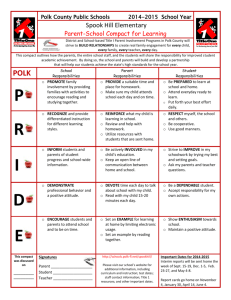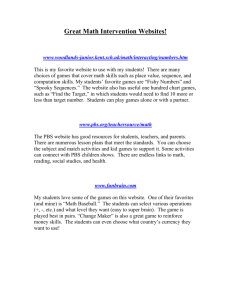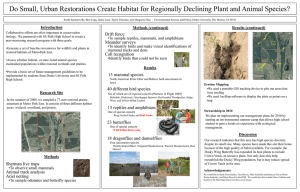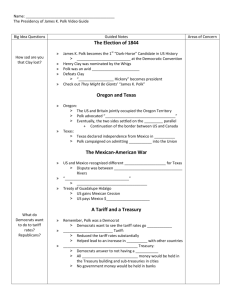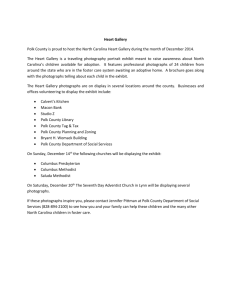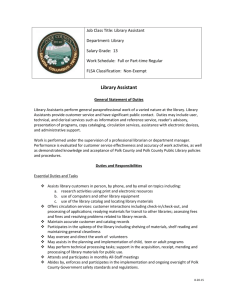IV.D Outcomes - Polk County Positive Behavior Support Network
advertisement
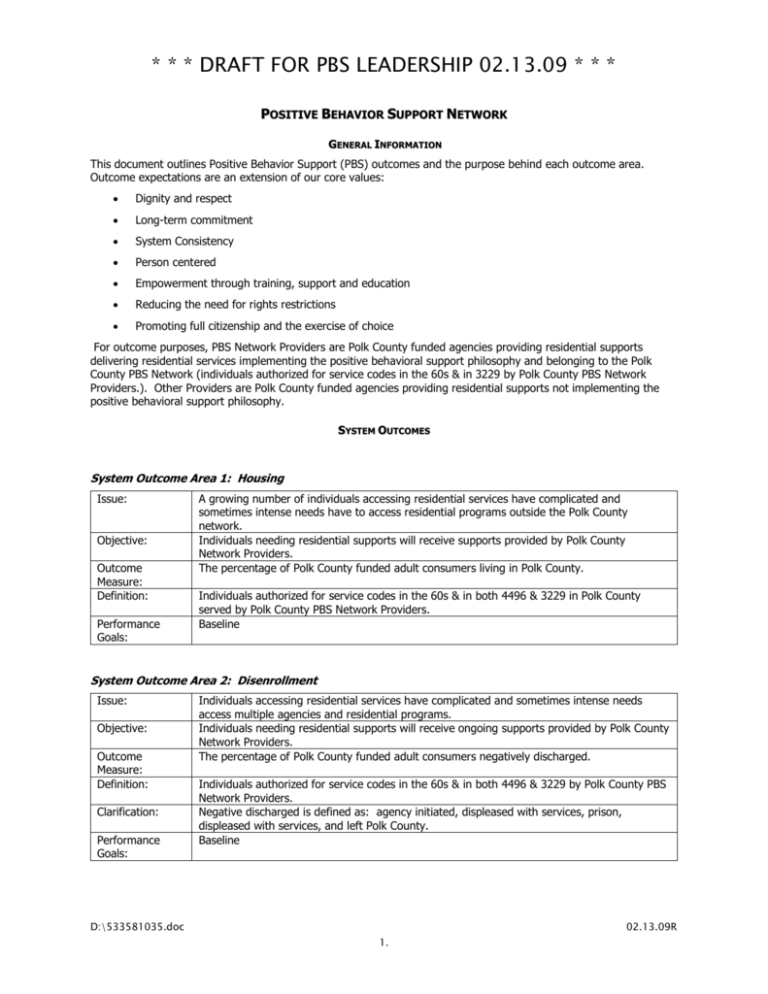
* * * DRAFT FOR PBS LEADERSHIP 02.13.09 * * * POSITIVE BEHAVIOR SUPPORT NETWORK GENERAL INFORMATION This document outlines Positive Behavior Support (PBS) outcomes and the purpose behind each outcome area. Outcome expectations are an extension of our core values: Dignity and respect Long-term commitment System Consistency Person centered Empowerment through training, support and education Reducing the need for rights restrictions Promoting full citizenship and the exercise of choice For outcome purposes, PBS Network Providers are Polk County funded agencies providing residential supports delivering residential services implementing the positive behavioral support philosophy and belonging to the Polk County PBS Network (individuals authorized for service codes in the 60s & in 3229 by Polk County PBS Network Providers.). Other Providers are Polk County funded agencies providing residential supports not implementing the positive behavioral support philosophy. S YS T E M O UT C O M E S System Outcome Area 1: Housing Issue: Objective: Outcome Measure: Definition: Performance Goals: A growing number of individuals accessing residential services have complicated and sometimes intense needs have to access residential programs outside the Polk County network. Individuals needing residential supports will receive supports provided by Polk County Network Providers. The percentage of Polk County funded adult consumers living in Polk County. Individuals authorized for service codes in the 60s & in both 4496 & 3229 in Polk County served by Polk County PBS Network Providers. Baseline System Outcome Area 2: Disenrollment Issue: Objective: Outcome Measure: Definition: Clarification: Performance Goals: Individuals accessing residential services have complicated and sometimes intense needs access multiple agencies and residential programs. Individuals needing residential supports will receive ongoing supports provided by Polk County Network Providers. The percentage of Polk County funded adult consumers negatively discharged. Individuals authorized for service codes in the 60s & in both 4496 & 3229 by Polk County PBS Network Providers. Negative discharged is defined as: agency initiated, displeased with services, prison, displeased with services, and left Polk County. Baseline D:\533581035.doc 02.13.09R 1. * * * DRAFT FOR PBS LEADERSHIP 02.13.09 * * * System Outcome Area 3a: Employment (Adults) Issue: Objective: Outcome Measure: Definition: Clarification: Clarification: Performance Goals: Unemployment is one of the most profound issues facing the disability community. Only 32% of Americans with disabilities aged 18 to 64 are working, but two-thirds of those unemployed would rather be working [source: The National Organization on Disability (N.O.D.)]. Employment is the key to self-sufficiency. The intent is to increase people with disabilities’ assets and to have the role of employee be seen as a viable role. The number of consumers working toward self-sufficiency during the year will increase. The percentage of employable adults with disabilities working 20 or more hours a week at or above minimum wage. Employable adults authorized for service codes in the 60s & in both 4496 & 3229 by Polk County PBS Network Providers working at or above 20 hours per week and at or above minimum wage. An employable adult is an individual between 18 and 64 years old with a level of support between 1 and 4. Adults not in the labor force are individuals not included in this area and are defined as individuals between 18 and 64 and supported at levels 5 and 6, involved in an ongoing recognized training program (secondary school, GED, or post secondary school), or individuals 65 or older choosing not to work. Baseline System Outcome Area 3b: Agency Involvement in Educational Settings (Children) Issue: Objective: Outcome Measure: Definition: Clarification Performance Goals: Education is the key to independence and future success; it is critical to obtaining work, and affects how much money one can earn. Before the passage of the Individuals with Disabilities Education Act (IDEA) in 1975, which granted all children with disabilities a free, appropriate public education, many children with disabilities did not attend school because the buildings or class activities were inaccessible. Even now, 22% of Americans with disabilities fail to graduate high school, compared to 9% of those without disabilities [source: The National Organization on Disability (N.O.D.)]. Many parents struggle with feeling comfortable with being assertive in asking schools to meet their son’s/daughter’s needs. Agency involvement in the school setting helps parents learn how to advocate and promotes collaboration between the education and disability systems. Increase PBS agency involvement in child consumers’ educational settings. The percentage of involvement in educational settings. [needs definition--] Involvement in educational settings is defined as the agency’s participation in IEP staffings, conferences, and/or other structured school-related meetings. The agency will participate in at least one structured meeting per child per year. Baseline System Outcome Area 4: Community Participation Issue: People with disabilities spend significantly less time outside the home, socializing and going out, than people without disabilities. They tend to feel more isolated, and participate in fewer community activities than their non-disabled counterparts. The largest differences exist between these two groups with regard to involvement in religious services, local politics, cultural events, outdoor activities, and community service organizations. Little or no differences exist with respect to participating in community events related to hobbies, participating in volunteer work, attending special community events such as fairs and parades, and attending recreational activities such as sporting events and movies. [Source: The National Organization on Disability (N.O.D.)]. The intent is to address these participation gaps and to remove barriers to community integration activities so people with disabilities can D:\533581035.doc 02.13.09R 2. * * * DRAFT FOR PBS LEADERSHIP 02.13.09 * * * Objective: Outcome Measure: Definition: Clarification: Performance Goals: participate with non-disabled people in community activities of their choice and become a part of the community. Consumers will access community activities. The percentage of consumers accessing and having ongoing involvement in 1 or more different community activities per year. Individuals authorized for service codes in the 60s & in both 4496 & 3229 by Polk County PBS Network Providers. Community participation activities are grouped into three main categories: spiritual, civic (local politics & volunteerism), and cultural (community events, clubs, and classes). An activity meets the definition if “yes” is the response to the following three questions: (1) Is the activity community-based and not sponsored by a provider agency? (2) Is the activity person-directed? And (3) Is the activity integrated? Consumers can participate in activities by themselves, with a friend/s, support staff person, or with natural supports. Examples include serving on an organization’s Board of Directors, being an involved church member or with the church, taking classes (non-employment related classes), participation in sporting events (volleyball league or little league baseball) or personal-interest groups (garden and chess clubs). Activities sponsored by or connected with an agency serving people with disabilities and everyday life activities do not count toward activities for the purposes of this outcome area. Baseline AGENCY OUTCOMES Agency Outcome Area 1: Workman’s Compensation Claims Issue: Objective: Outcome Measure: Definition: Clarification: Reporting Period: Reporting Requirements: Performance Goals: Workman’s compensation claims are costly to agencies in time staff are away from work, result in increased medical/insurance costs and can cause staffing shortages and decreased continuity of care. Situations resulting in a workman’s compensation claim may also lead to increased staff turnover. Decrease workman’s compensation claims Number of claims per quarter and cumulative through the fiscal year Aggression (biting, hitting, kicking, or throwing causing injury) toward staff that resulted in time off, days with restrictions or job transfers, or injuries that resulted in death Identifier questions: (1) Was the Workman’s comp claim a direct result of a consumer physically assaulting the staff or emotional trauma suffered due to multiple or significant consumer behavior issues? (2) Did staff visit a physician after the incident? and (3) Did staff miss work or have physician restrictions on work activities? Quarterly with annual summary; based on a July 1 to June 30 fiscal year Quarterly data to PCHS by the end of the month following the quarter (e.g., reporting period of July, August, September reported to PCHS by October 31) Baseline July 1, 2008 through June 30, 2009. Agency Outcome Area 2: Staff Turnover Issue: Objective: Outcome Measure: Definition: Staff turnover causes increased financial costs, quality of care issues, and could be an opportunity cost for potential growth. Decrease number of separations due to job dissatisfaction Separations due to job satisfaction as a percentage of total turnover Staff who separate from the organization because of physical injury or emotional trauma or other reasons due to multiple or significant consumer behavior issues. D:\533581035.doc 02.13.09R 3. * * * DRAFT FOR PBS LEADERSHIP 02.13.09 * * * Reporting Period: Reporting Requirements: Performance Goals: Quarterly with annual summary; based on a July 1 to June 30 fiscal year Quarterly data to PCHS by the end of the month following the quarter (e.g., reporting period of July, August, September reported to PCHS by October 31) Baseline July 1, 2008 through June 30, 2009. Agency Outcome Area 3: Major Critical Incident Reports Issue: Objective: Outcome Measure: Definition: Reporting Period: Reporting Requirements: Performance Goals: Major critical incidents are an indicator of success in supporting individuals To decrease the number of critical incidents Number of major critical incidents Major critical incident types include: Injury to/by individual requiring physician treatment; Injury to/by individual requiring hospital admission; Death of individual; Emergency mental health treatment; Intervention of law enforcement; Reportable to protective services; An incident that results from a pattern of prescription medication errors Quarterly with annual summary; based on July to June Fiscal Year Quarterly data to PCHS by the end of the month following the quarter (e.g., reporting period of July, August, September reported to PCHS by October 31) Baseline July 1, 2008 through June 30, 2009. INDIVIDUAL OUTCOMES (TO BE DEVELOPED) Individual Outcome Area 1: Use of PRN Medication for Behavior Management Individual Outcome Area 2: Participant Satisfaction Individual Outcome Area 3: Family/Guardian Satisfaction D:\533581035.doc 02.13.09R 4.
